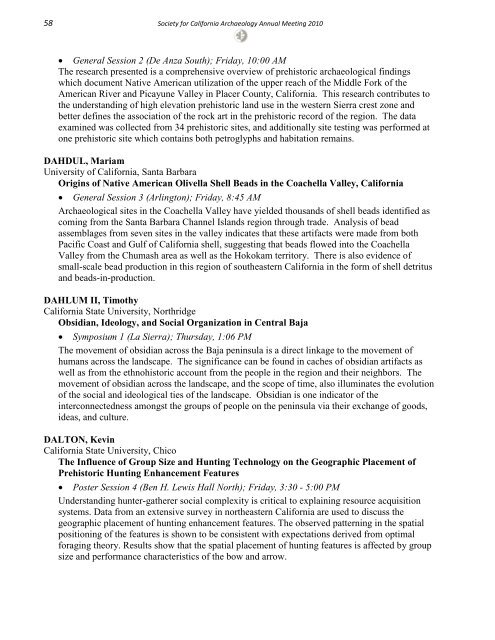Society for California Archaeology 2010 Annual Meeting
Society for California Archaeology 2010 Annual Meeting
Society for California Archaeology 2010 Annual Meeting
Create successful ePaper yourself
Turn your PDF publications into a flip-book with our unique Google optimized e-Paper software.
58 <strong>Society</strong> <strong>for</strong> Cali<strong>for</strong>nia <strong>Archaeology</strong> <strong>Annual</strong> <strong>Meeting</strong> <strong>2010</strong><br />
• General Session 2 (De Anza South); Friday, 10:00 AM<br />
The research presented is a comprehensive overview of prehistoric archaeological findings<br />
which document Native American utilization of the upper reach of the Middle Fork of the<br />
American River and Picayune Valley in Placer County, Cali<strong>for</strong>nia. This research contributes to<br />
the understanding of high elevation prehistoric land use in the western Sierra crest zone and<br />
better defines the association of the rock art in the prehistoric record of the region. The data<br />
examined was collected from 34 prehistoric sites, and additionally site testing was per<strong>for</strong>med at<br />
one prehistoric site which contains both petroglyphs and habitation remains.<br />
DAHDUL, Mariam<br />
University of Cali<strong>for</strong>nia, Santa Barbara<br />
Origins of Native American Olivella Shell Beads in the Coachella Valley, Cali<strong>for</strong>nia<br />
• General Session 3 (Arlington); Friday, 8:45 AM<br />
Archaeological sites in the Coachella Valley have yielded thousands of shell beads identified as<br />
coming from the Santa Barbara Channel Islands region through trade. Analysis of bead<br />
assemblages from seven sites in the valley indicates that these artifacts were made from both<br />
Pacific Coast and Gulf of Cali<strong>for</strong>nia shell, suggesting that beads flowed into the Coachella<br />
Valley from the Chumash area as well as the Hokokam territory. There is also evidence of<br />
small-scale bead production in this region of southeastern Cali<strong>for</strong>nia in the <strong>for</strong>m of shell detritus<br />
and beads-in-production.<br />
DAHLUM II, Timothy<br />
Cali<strong>for</strong>nia State University, Northridge<br />
Obsidian, Ideology, and Social Organization in Central Baja<br />
• Symposium 1 (La Sierra); Thursday, 1:06 PM<br />
The movement of obsidian across the Baja peninsula is a direct linkage to the movement of<br />
humans across the landscape. The significance can be found in caches of obsidian artifacts as<br />
well as from the ethnohistoric account from the people in the region and their neighbors. The<br />
movement of obsidian across the landscape, and the scope of time, also illuminates the evolution<br />
of the social and ideological ties of the landscape. Obsidian is one indicator of the<br />
interconnectedness amongst the groups of people on the peninsula via their exchange of goods,<br />
ideas, and culture.<br />
DALTON, Kevin<br />
Cali<strong>for</strong>nia State University, Chico<br />
The Influence of Group Size and Hunting Technology on the Geographic Placement of<br />
Prehistoric Hunting Enhancement Features<br />
• Poster Session 4 (Ben H. Lewis Hall North); Friday, 3:30 - 5:00 PM<br />
Understanding hunter-gatherer social complexity is critical to explaining resource acquisition<br />
systems. Data from an extensive survey in northeastern Cali<strong>for</strong>nia are used to discuss the<br />
geographic placement of hunting enhancement features. The observed patterning in the spatial<br />
positioning of the features is shown to be consistent with expectations derived from optimal<br />
<strong>for</strong>aging theory. Results show that the spatial placement of hunting features is affected by group<br />
size and per<strong>for</strong>mance characteristics of the bow and arrow.

















